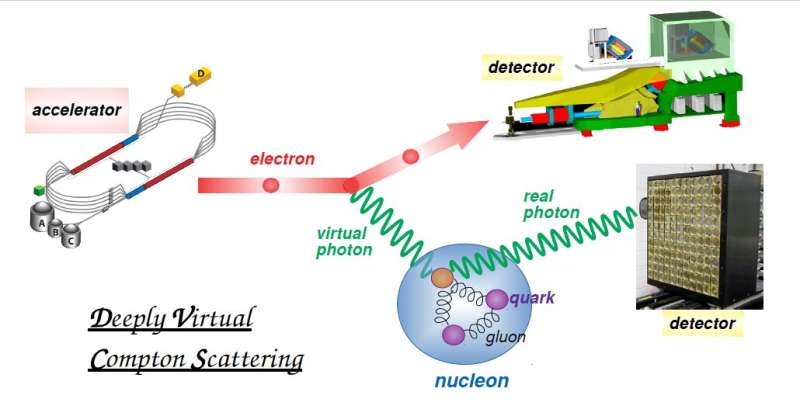February 19, 2020 feature
3-D imaging the flavor content of the nucleon

The Jefferson Lab Hall A Collaboration, in an experiment led by researchers at Faculté des Sciences de Monastir in Tunisia, Institut de Physique Nucléaire d'Orsay in France and Old Dominion University in the United States, has recently gathered the first experimental observations of deeply virtual Compton scattering (DVCS) in neutrons. Their experiment, whose results were published in Nature Physics, was motivated by generalized parton distributions (GPDs), a recently developed theoretical framework that describes the internal dynamics of the nucleon (proton or neutron) in terms of quarks and gluons. DVCS is the simplest process involving GPDs. It consists of the scattering of an electron off a nucleon and the emission of a high-energy photon while the nucleon remains intact.
"Protons and neutrons consist of waves of quarks and gluons confined into a space approximately 100,000 times smaller than the size of an atom," Prof. Charles Hyde, a researcher at Old Dominion University in Virginia, told Phys.org. "This paper, resulting from work in Jefferson Lab's Hall A, can be described as hitting a proton or neutron with a high-energy electron, and then detecting an emitted gamma-ray to 'take-a-picture' of the quark waves."
In their work, Hyde and his colleagues demonstrated a new technique to separately resolve the spatial distribution of up and down quarks of particular wavelengths (i.e., crest-to-crest distance), while also measuring the offset between the wave crests of up and down quarks. Using this technique, they were able to gather the first experimental observation of DVCS in neutrons.
"Studying deeply virtual Compton scattering (DVCS) off the neutron came as a natural extension of studies on the proton," Dr. Carlos Munoz Camacho, researcher at the Institut de Physique Nucléaire d'Orsay in France, told Phys.org. "DVCS can tell us about the transverse position and longitudinal momentum of quarks inside the nucleon. However, DVCS experiments on the proton alone cannot tell which flavor of quark the photon scatters from."
As no neutron target is entirely pure, experimentally studying DVCS off the neutron can be very challenging. By performing DVCS off the neutron and combining the results with those gathered in previous experiments on protons, the researchers were able to map the position and momenta of up and down quarks inside the nucleon independently.
In their experiments, the researchers decided to use a deuterium target, a nucleus formed by one proton and one neutron, impinged by a 6GeV polarized electron beam. This beam was provided by the Thomas Jefferson National Accelerator Facility (JLab) in Newport News, Virginia.
"We measured the scattered electrons and the energetic photons emitted during the reaction using high precision detectors," Dr. Meriem Benali, who recently attained her Ph.D. from Faculté des Sciences de Monastir in Tunisia, told Phys.org. "The recoil neutron was identified using a technique called energy-momentum conservation."
The researchers compared the data they collected in their experiment on the deuterium nucleus to data gathered in the past using hydrogen targets (i.e., a nucleus with only one proton). This allowed them to identify rare DVCS events occurring in neutrons, determining the contributions of the up and down quarks separately.
"Our results prove the experimental feasibility of neutron DVCS measurements, which are highly complementary to proton ones," Dr. Malek Mazouz, professor at Faculté des Sciences de Monastir in Tunisia, told Phys.org. "Since the neutron has a different quark flavor content than the proton, the combination of neutron and proton measurements allowed us, for the first time, to experimentally study the GPDs at the quarks level."
DVCS is a difficult process to measure, especially off a neutron. As a neutron carries no net electrical charge, its probability of interacting with electrons is much smaller than that of a proton.
The so-called A collaboration was enabled by several technical advancements, including the intense beam of electrons provided by JLab and high precision detectors. To ensure its success, the researchers monitored the calibration of the detectors with extreme care over the several months in which their experiment took place.
"Protons and neutrons are like spinning tops," Hyde said. "A surprising result of our study is that by using the full energy range of the Jefferson Lab accelerator, the measurements could also distinguish how the distribution of quarks in the proton and neutron changes with the orientation of the proton or neutron spin."
This team of researchers was the first to successfully observe the DVCS process off the neutron, which is an important accomplishment. By adding a number of constraints to GPD models, their findings could help to answer a number of fundamental questions, for instance unveiling the origin of the nucleon spin. In addition, their work opens a new avenue for the experimental mapping of independent quark flavors inside a nucleon.
"The accelerator facility at JLab has recently been upgraded and the energy of the electron beam is much higher (11 GeV)," Munoz Camacho said. "New DVCS experiments are on-going and planned for the future, which will allow us to map out the distributions of quarks inside the nucleon with greater precision. DVCS measurements are also one of the scientific motivations for the future Electron-Ion Collider (EIC) project, planned to be built at Brookhaven National Laboratory (NY, U.S.)."
The new collider at Brookhaven National Laboratory should soon allow researchers to study the position and momentum distributions of gluons, the particles that hold quarks together inside protons and neutrons. In fact, quark and gluon imaging is a key component of the science program for the development of the new Electron-Ion collider, which was recently announced by the U.S. Department of Energy.
More information: M. Benali et al. Deeply virtual Compton scattering off the neutron, Nature Physics (2020). DOI: 10.1038/s41567-019-0774-3
Journal information: Nature Physics
© 2020 Science X Network





















